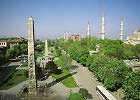 This tour is designed to give you a glimpse of the best and the most
famous monuments in Istanbul remaining from Byzantine Empire era.
This tour is designed to give you a glimpse of the best and the most
famous monuments in Istanbul remaining from Byzantine Empire era.
Secret Treasures of Istanbul(IST - 05) Full Day with Lunch
 This tour is designed to give you a glimpse of the best and the most
famous monuments in Istanbul remaining from Byzantine Empire era.
This tour is designed to give you a glimpse of the best and the most
famous monuments in Istanbul remaining from Byzantine Empire era.
Depart from the pier for an interesting tour of Istanbul with a city sightseeing drive through the business centre of the modern city, across the Galata Bridge, along the banks of the Golden Horn and under the Byzantine Aqueduct of Valens. On the way, see the Süleymaniye Mosque dedicated to Sultan Süleyman the Magnificent, built by the famous Turkish Architect, Sinan.
Arrive at Chora Museum. This 11th century church of St. Savior in Chora is the most important Byzantine monument in Istanbul after the St. Sophia museum. It displays a collection of fourteenth century frescoes, gold-inlaid mosaics and some of the World's finest Byzantine paintings. Continue with a drive along the ancient Byzantine city walls to arrive at the Byzantine Hippodrome where the chariot races and celebrations in honour of the emperors once took place during Byzantine Empire era. Visit the ancient church of St.Sergius and Bachus which belonged to the monastery of Hormisdas and was built as the result of a vow made by Justinian when he was on the point of being executed for conspiring against his predecessor.
 The tour continues with a visit to an Underground Cistern, consisting of a network of
waterways built as far back as the third century BC, to protect the city against
long sieges. Continue to Balat area, another historical part of Istanbul for
lunch at the restaurant. After the lunch, you can visit The Patriarchate which is located
just 50m away from the restaurant or you can relax walking along the Golden Horn.
The tour continues with a visit to an Underground Cistern, consisting of a network of
waterways built as far back as the third century BC, to protect the city against
long sieges. Continue to Balat area, another historical part of Istanbul for
lunch at the restaurant. After the lunch, you can visit The Patriarchate which is located
just 50m away from the restaurant or you can relax walking along the Golden Horn.
Drive to Rustem Pasha Mosque, located at Eminonu close to the Spice Market. This Mosque was built by Sinan in 1550 for Rustem Pasha, a grand vizier who married one of the daughters of Süleyman the Magnificent. Inside and on the facade you see some beautiful Iznik faience. The Mihrab completely covered with faience tiles and the Mimbar are particularly striking.
Remarks